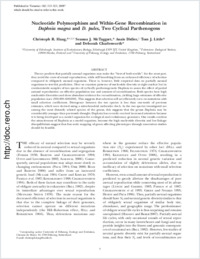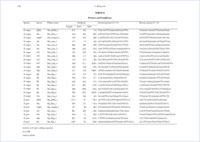Nucleotide polymorphism and within-gene recombination in Daphnia magna and D. pulex, two cyclical parthenogens
- Haag, Christoph R. University of Edinburgh, Institute of Evolutionary Biology, Kingdom - Tvärminne Zoological Station, Hanko, Finland - University of Fribourg, Ecology and Evolution, Switzerland
- McTaggart, Seanna J. University of Edinburgh, Institute of Evolutionary Biology, Kingdom
- Didier, Anaïs University of Fribourg, Ecology and Evolution, Switzerland
- Little, Tom J. University of Edinburgh, Institute of Evolutionary Biology, Kingdom
- Charlesworth, Deborah University of Edinburgh, Institute of Evolutionary Biology, Kingdom
-
18.03.2009
Published in:
- Genetics. - 2009, vol. 182, p. 313-323
English
Theory predicts that partially asexual organisms may make the "best of both worlds": for the most part, they avoid the costs of sexual reproduction, while still benefiting from an enhanced efficiency of selection compared to obligately asexual organisms. There is, however, little empirical data on partially asexual organisms to test this prediction. Here we examine patterns of nucleotide diversity at eight nuclear loci in continentwide samples of two species of cyclically parthenogenetic Daphnia to assess the effect of partial asexual reproduction on effective population size and amount of recombination. Both species have high nucleotide diversities and show abundant evidence for recombination, yielding large estimates of effective population sizes (300,000–600,000). This suggests that selection will act efficiently even on mutations with small selection coefficients. Divergence between the two species is less than one-tenth of previous estimates, which were derived using a mitochondrial molecular clock. As the two species investigated are among the most distantly related species of the genus, this suggests that the genus Daphnia may be considerably younger than previously thought. Daphnia has recently received increased attention because it is being developed as a model organism for ecological and evolutionary genomics. Our results confirm the attractiveness of Daphnia as a model organism, because the high nucleotide diversity and low linkage disequilibrium suggest that fine-scale mapping of genes affecting phenotypes through association studies should be feasible.
- Faculty
- Faculté des sciences et de médecine
- Department
- Département de Biologie
- Language
-
- English
- Classification
- Biological sciences
- License
- License undefined
- Identifiers
-
- RERO DOC 12613
- DOI 10.1534/genetics.109.101147
- Persistent URL
- https://folia.unifr.ch/unifr/documents/301194
Other files
Statistics
Document views: 111
File downloads:
- haag_npw.pdf: 166
- haag_npw_sm.pdf: 105

